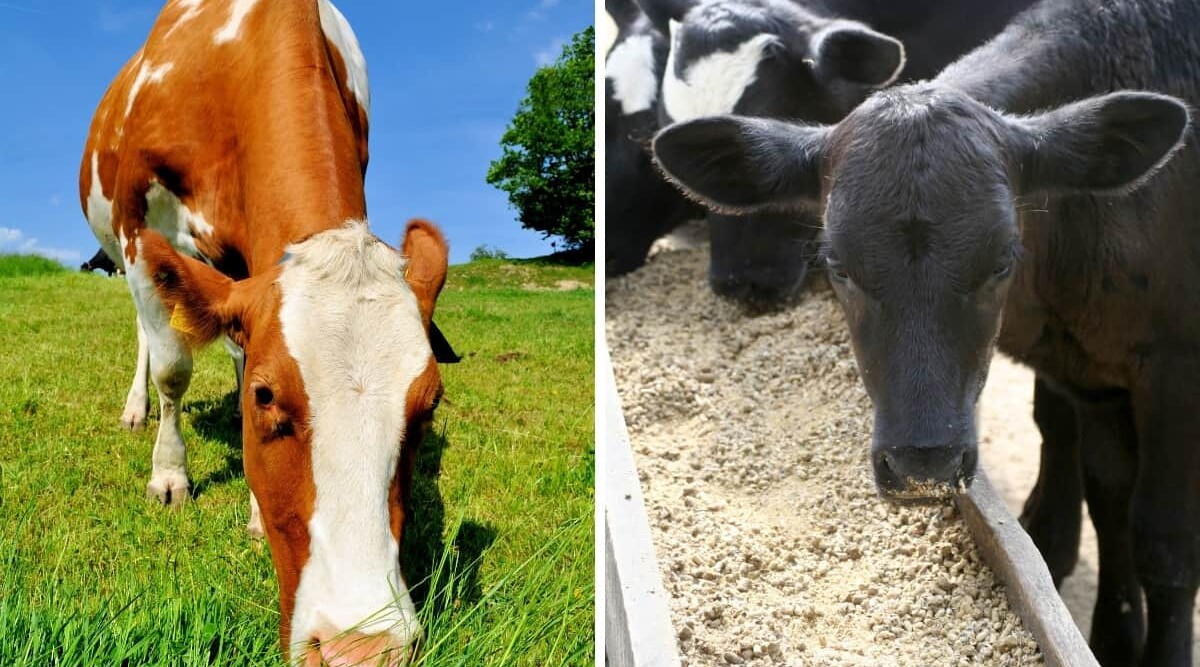
But when buying your beef, do you know the differences between the often confusing and ambiguous names given to different beef production methods? There is grass-fed, grass-finished, grain-fed, grain-finished, pasture-raised, free-range, organic, and naturally-raised.
Grass-fed beef differs from grain-fed beef primarily in its nutritional profile, the environmental impact of how the cattle are raised, and their taste and flavor, reflecting the different diets and farming practices used in the production of the beef.
You can lose a good thirty minutes sifting through all the options at the store and still not be entirely sure you’ve made the right choice.
Many assume that natural and more expensive must be better, but it’s not as simple as that. And what’s “better” anyway? Better taste, better for you, better for the animal, or better for the planet? That’s a heck of a lot of thinking when you’re just trying to get through your shopping list.
In this post, we’ll clear up the confusion. We’ll help clarify what the different cattle-raising terms mean and explain the differences between taste, healthfulness, price, and environmental impact.
Jump to:
- 1 6 At a Glance Comparison Tables of Grass Fed Vs Grain Fed Beef
- 2 A Detailed Look at Grass-Fed Beef
- 3 A Detailed Look at Grain-Fed Beef
- 4 Do Grass-Fed Beef and Grain-Fed Beef Taste Different?
- 5 Which is Healthier for You, Grass Fed or Grain Fed Beef?
- 6 Is the Nutritional Difference Between Grass Fed and Grain-Fed Beef Much Ado About Nothing?
- 7 Price Difference Between Grass-Fed and Grain-Fed Beef
- 8 Which is better for the Cows? Feeding Grass or Grain?
- 9 What is the Environmental Impact of Grain-Feeding Compared to Grass-Feeding?
- 10 Should You Cook Grass-Fed Beef Differently from Grain-Fed Beef?
- 11 A Word about Pasture-Raised, Organic, and Free-Range.
- 12 What’s Your Beef?
6 At a Glance Comparison Tables of Grass Fed Vs Grain Fed Beef
I initially created one large table comparing grass-fed to grain-fed beef. But, it was too large, making it hard to read and understand. It also looked shockingly bad on mobile devices, where most of you will be reading this, so I decided to split it into six smaller targeted ones.
1. Nutritional Content
This table compares the nutritional differences between grass-fed and grain-fed beef, including fat content, omega fatty acids, and vitamins.
| Parameter | Grass-Fed Beef | Grain-Fed Beef |
|---|---|---|
| Fat Content | Lower total fat, less saturated fat | Higher total fat, more saturated fat |
| Omega Fatty Acids | Higher in Omega-3, better omega-3 to omega-6 ratio | Higher in Omega-6, less optimal omega ratio |
| Vitamins & Minerals | Higher in Vitamins B12, E, and essential minerals like iron and zinc | Lower levels of these vitamins and minerals |
| Antioxidants | Contains more antioxidants like carotenoids and tocopherols | Fewer antioxidants compared to grass-fed |
| Caloric Value | Fewer calories per serving due to lower fat content | Higher calories due to increased fat content |
2. Environmental Impact
Explore the environmental impacts of grass-fed versus grain-fed beef, focusing on carbon footprint, land and water use, and biodiversity.
| Parameter | Grass-Fed Beef | Grain-Fed Beef |
|---|---|---|
| Carbon Footprint | Lower greenhouse gas emissions per animal | Higher greenhouse gas emissions per animal |
| Land Use | Requires extensive grazing land, can lead to overgrazing | More efficient land use for feed production |
| Water Usage | Generally lower water footprint for grazing | Higher water usage for feed and maintenance |
| Biodiversity | Can support biodiversity through rotational grazing | Often leads to reduced biodiversity due to monoculture crops for feed |
3. Animal Welfare
This table highlights the differences in animal welfare practices between grass-fed and grain-fed beef, including living conditions and feed quality.
| Parameter | Grass-Fed Beef | Grain-Fed Beef |
|---|---|---|
| Living Conditions | Often have access to open pastures | Typically confined to feedlots |
| Feed Quality | Natural grass diet, more varied and healthier | Grain-based diet, less natural for cattle |
| Antibiotics and Hormones | Less reliance on antibiotics and growth hormones | More frequent use of antibiotics and hormones for faster growth |
4. Economic Aspects
Compare the economic aspects of producing grass-fed versus grain-fed beef, including production costs, market price, and availability.
| Parameter | Grass-Fed Beef | Grain-Fed Beef |
|---|---|---|
| Cost of Production | Higher due to longer growth period and land use | Lower due to faster growth and efficient feeding |
| Market Price | Premium price reflecting higher production costs | Generally more affordable due to lower costs |
| Availability | Limited availability, niche market | Widely available in most markets and stores |
5. Taste and Texture
Examine the distinctions in taste and texture between grass-fed and grain-fed beef, from flavor profiles to meat tenderness.
| Parameter | Grass-Fed Beef | Grain-Fed Beef |
|---|---|---|
| Flavor Profile | Distinctive, earthy, and gamey flavor | Milder flavor, often described as sweeter or neutral |
| Texture | Typically firmer due to leaner muscle, less marbling | More tender with higher fat marbling |
6. Health Implications
This table outlines the health implications of consuming grass-fed versus grain-fed beef, including allergies and overall health benefits or risks.
| Parameter | Grass-Fed Beef | Grain-Fed Beef |
|---|---|---|
| Allergies & Sensitivities | Generally lower risk of causing allergies | Possible higher risk of allergies due to additives |
| Health Benefits/Risks | Associated with lower risk of heart disease and better overall fat profile | Linked to higher levels of unhealthy fats, potential for increased health risks |
A Detailed Look at Grass-Fed Beef
Let’s move on with a comprehensive overview of grass-fed beef, focusing on its production methods, nutritional advantages, and environmental effects.
What is Grass Fed Beef?
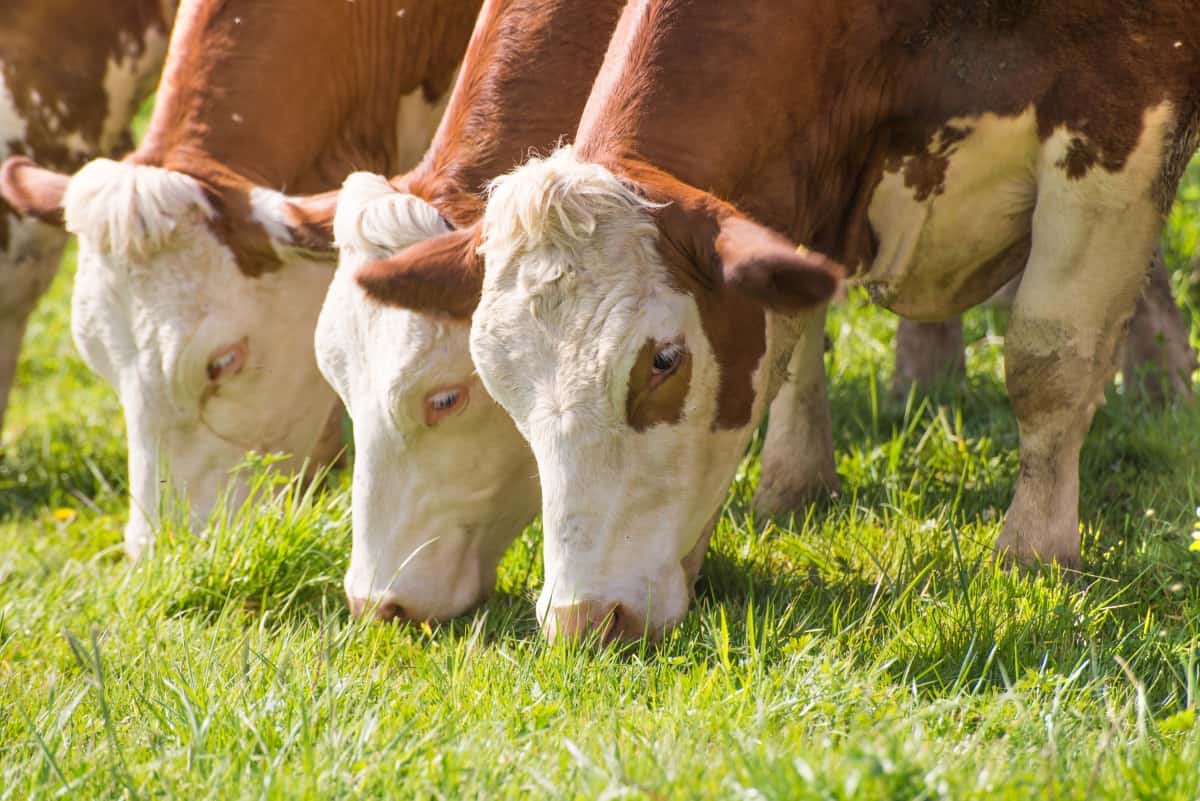
The term “grass-fed” is often unclear and can be misleading. Although all cows graze on pastures for some of their lives in the US, most eventually move to feedlots. This means “grass-fed” beef isn’t always 100% grass-fed, confusing customers looking for fully pasture-raised beef.
Moreover, to capitalize on the rising popularity of grass-fed beef, producers sometimes add forage to grain feed and still label their beef as “grass-fed.” However, these cows are often raised in crowded feedlots, not open pastures, and may still receive hormones and antibiotics.
Supporters of true grass-fed beef emphasize that it’s about more than diet. It includes cows moving freely and grazing in natural settings, which they believe leads to higher quality and better-tasting beef. However, the term’s meaning has become even more uncertain since the USDA’s Agricultural Marketing Service dropped its official definition in 2016. Now, the label is frequently used more for marketing, with little regard for its original meaning.
To ensure you’re buying genuinely 100% grass-fed beef, look for the American Grassfed Association (AGA) logo.
For an excellent and in-depth look at the history and ambiguity of beef labeling in the United States, click here.
What is Grass-Finished Beef?
Grass-finished beef means the cows are fed only grass or forage for their whole lives. They usually stay in open pastures and often don’t receive antibiotics or hormones.
The term “finished” in farming refers to the final feeding stage of cattle. After about six months in a field, they’re either kept on grass (grass-finished) or moved to feedlots for grain feeding (grain-finished).
A key point is that while all grass-finished cows are grass-fed, not all grass-fed cows are grass-finished. Some may have spent little time eating grass. To be certain you’re buying beef from cows fed only on grass, look for “grass-finished” on the label or the American Grassfed Association’s (AGA) logo.
It’s confusing here because the AGA uses the term “grass-fed” rather than “grass-finished.” But their definition is solid and reliable. Here’s what the AGA says about their standard for grass-fed:
“AGA defines grass-fed animals as those that have eaten nothing but grass and forage from weaning to harvest, have not been raised in confinement, and have never been fed antibiotics or growth hormones. In addition, all AGA-Certified Producers are American family farms and their livestock is born and raised in the US.”
Note that this is the AGA’s definition of grass-fed and not at all a universal standard.
What is in the Grass?
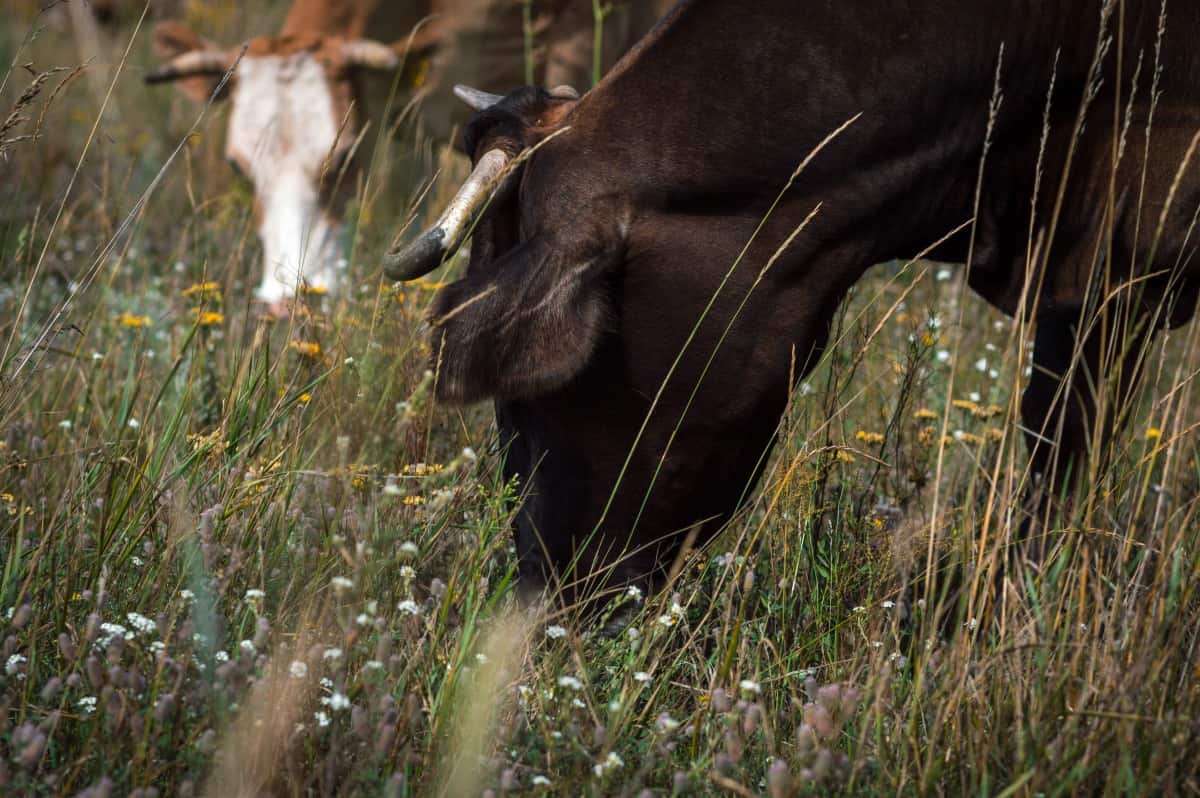
What is in the grass cows eat? Well, there’s some variation here, of course, because who knows exactly what a cow will chomp down on as it roams across the range?
But safe to say it’s a mix of fescue, clover, alfalfa, and other natural grasses. These too will be dried into hay and forage for winter feeding under cover when it’s too cold for cows to be outside.
Why Grass-Fed is Smart
- It’s the natural, healthy, and humane way to raise cattle who are designed to eat grass, not grain
- Although it takes more land, pasture-raising helps restore natural ecosystems, naturally fertilizes the land, and scientists maintain that the vast quantities of methane (a greenhouse gas pollutant) produced by cows can be “sequestered” (trapped safely) in the soil, which makes the practice eco-friendly
- It produces a leaner, healthier beef (more on that in a minute!)
A Detailed Look at Grain-Fed Beef
What is Grain-Fed Beef?
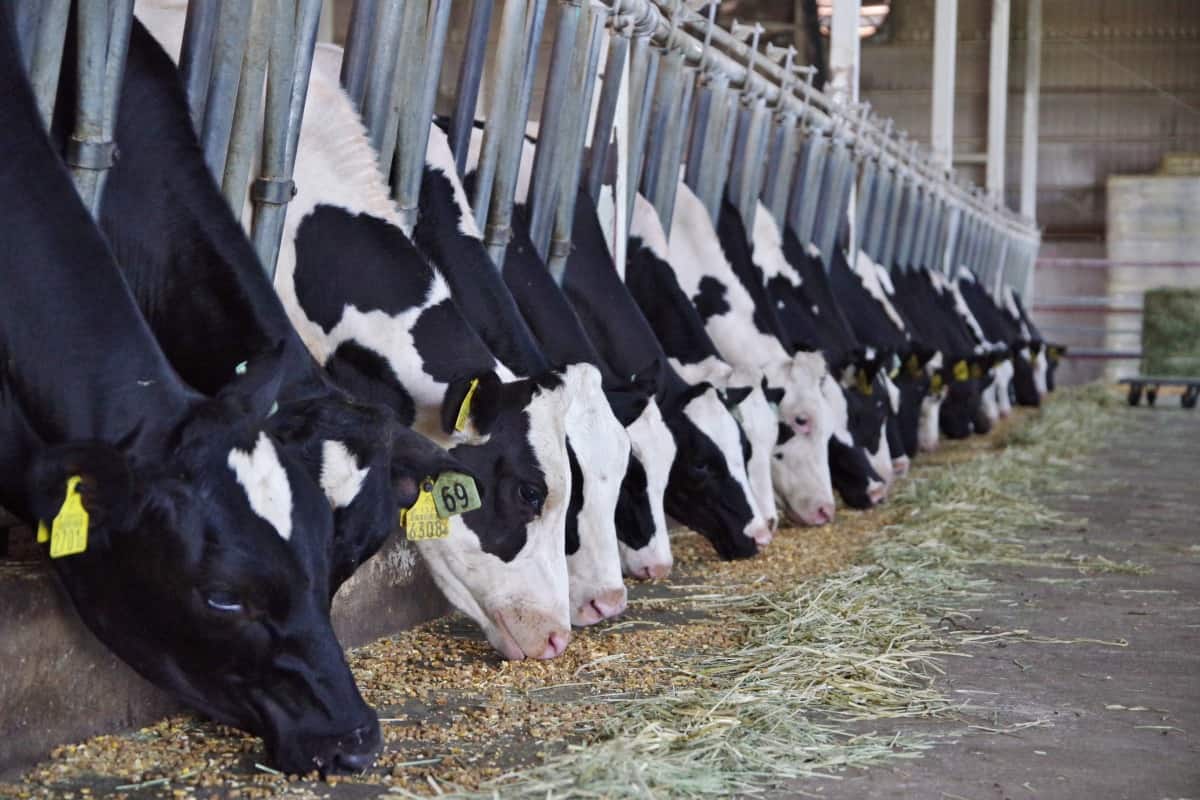
Grain-feeding cattle, mainly with corn, soy, and other grains, became popular in the 1950s and is now standard in U.S. beef production. This method is not natural for cows, but they do adapt to it. It’s a faster and cheaper cattle-raising method than pasture-raising, resulting in heavier, more marbled meat.
Grain-fed cows reach slaughter weight up to a year sooner than pasture-raised cows, allowing producers to cycle more product and keep prices lower. Feedlots, or Concentrated Animal Feeding Operations (CAFOs), enable raising more cattle in less space. This results in lower-cost meat for consumers, with juicier, more marbled cuts due to the cows’ limited movement and high-calorie diet.
However, there are downsides. Grain-fed cows often receive growth hormones and antibiotics to speed up weight gain. In fact, 80% of antibiotics in the U.S. are used in animal feed. These antibiotics are necessary because a cow’s digestive system isn’t designed for low-fiber corn diets, making them prone to sickness. Additionally, crowded feedlots create unhealthy living conditions, leading to more disease and further antibiotic use. This overuse of antibiotics is a major public health concern, as noted by the CDC.
The implications of consuming meat from animals raised on growth hormones and antibiotics is worth considering. The saying “you are what you eat” extends to what your food consumes.
What is Grain-Finished Beef?
Grain-finished is the widespread and highly efficient practice of moving cows from pasture after 6-8 months into feedlots (also known as Concentrated Animal Feeding Operations or CAFOs).
Here, cows will be grain-fed intensively for 3-5 months in readiness for slaughter.
What is in the Grain?
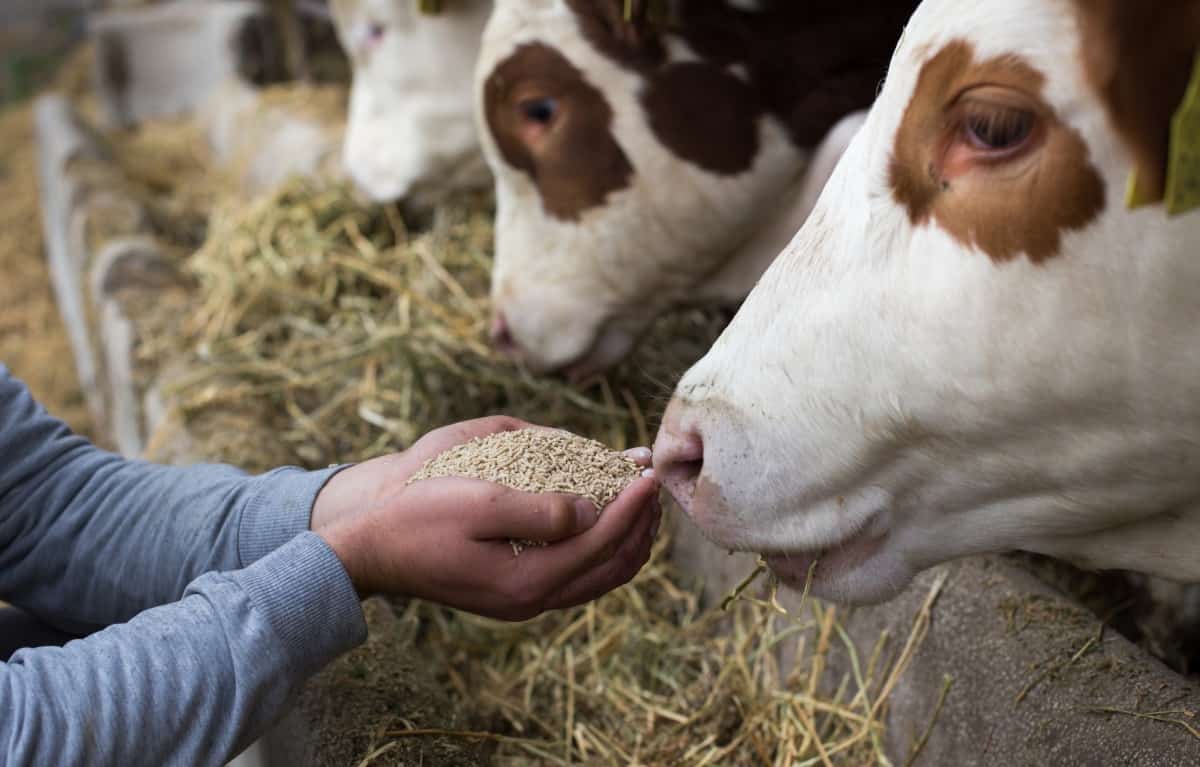
The grain fed to cows in feedlots is typically an energy-dense mix of corn, soy, sometimes oats, barley, and other grains. It also contains antibiotics to prevent the animals from getting sick from this diet, which is unnatural.
Growth hormones are often also added to speed up their weight gain so that farmers can get them to market sooner, which is more cost-effective for the farmer.
Why Grain-Fed is Smart
- It takes less space because thousands of animals can be raised in relatively small areas.
- It takes less time as grain-fed cows achieve maturity and are ready for market around x to x months.
- It is not weather dependent. Grain can be trucked in from other parts of the country.
- It is easy to control quality and make the end-product uniform because all cows are receiving exactly the same treatment and feed.
- It creates a juicy, well-marbled beef that consumers like at an affordable price.
Want more info? Read more here on the differences between grain-fed and grass-fed beef.
Do Grass-Fed Beef and Grain-Fed Beef Taste Different?
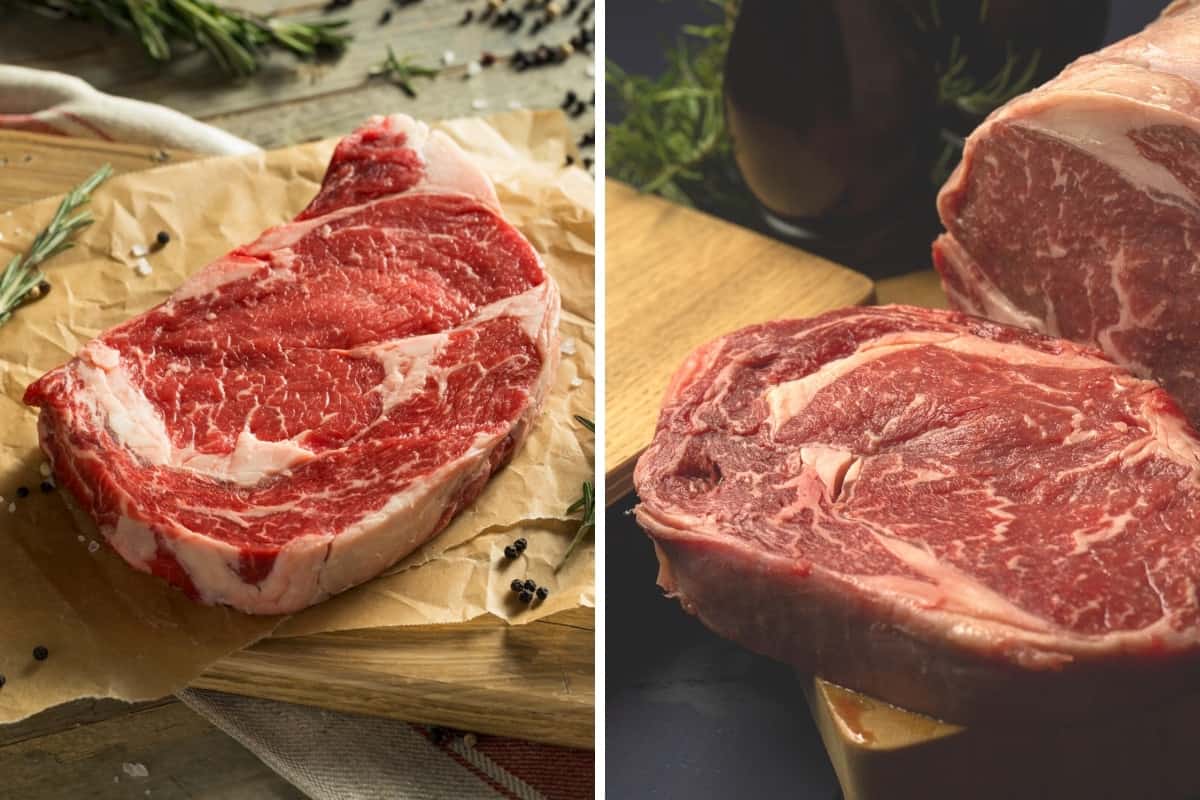
OK, now we’re down to the nitty-gritty! Do grass fed-beef and grain fed beef taste different? You bet they do!
So grab your fork, and let’s get stuck in with a discussion on flavor and texture differences.
How does Grass-Fed Beef Taste?
Taste panels describe grass-fed beef as a stronger, beefier flavor. “Intense,” “robust” and “pure” are other words used to describe this beef which some say “tastes like beef used to taste.”
Some of this stronger flavor is the result of a higher protein-to-fat ratio in grass-fed cows. And some is because grass-fed beef is often aged a little longer than grain-fed to help break down tough connective tissue and tenderize the meat before cooking. You can read more about the fascinating science of aging meat here in our article on dry aging.
A cow that roams all its life (as opposed to one who is largely immobile in a feedlot) is a fitter, leaner, more muscular animal, which affects the meat it produces.
Grass-fed beef is darker in color with less marbling, and yellower fat due to higher levels of beta-carotene.
Because of the leaner quality of the meat, care is needed in grilling to not end up with a tough and chewy steak. Taking time to tenderize your grass-fed beef either with marinades, salt, or pounding will ensure a juicy, melt-in-the-mouth bite.
Slow cooking will also help to break down tough meat fibers. Or — counter-intuitively — grilling on high heat very quickly to medium-rare will also ensure the meat stays tender. It’s the in-between cooking you want to avoid. Medium to well-done with grass-fed beef that has not been tenderized could work the jaw-bone more than you care to.
This is not to say that grass-fed beef is not as tasty as grain-fed. On the contrary, many prefer the stronger, leaner flavor. You just need to take a little more care in grilling to prevent a chewy dry result.
Of course, with ground meat, there is no issue with texture. So, grass-fed beef is a great choice for your next burger night.
How Does Grain-Fed Beef Taste?
Besides being the most profitable way for farmers to produce beef for this burger-and-steak-loving nation, there’s another very good reason to love grain-fed beef. It tastes great.
The heavier grain-fed cow produces a prized beautifully-marbled beef that grills up easily and is juicy, rich-tasting, and buttery smooth. There’s not much to dislike about grain-fed beef, and it’s still the #1 choice for many chefs and restaurants.
Which is Healthier for You, Grass Fed or Grain Fed Beef?

The question of grass-fed or grain-fed beef being healthier gets everyone fired up…the beef industry, the health advocates, farmers, and chefs alike. There’s lots of differing opinions!
So what’s the skinny here? Let’s look at the facts on health benefits between the two types of beef.
Which is Lower in Fat and Calories?
Grass-fed beef is lower in fat and calories than grain-fed beef. Since the grain that producers use is variable from one to the next, and some mix in forage and hay and others don’t, there is no absolute precise number here. But it has been shown that a 6-oz grass-fed beef tenderloin has around 92 calories less than the same from a grain-fed cow.
This adds up! If you’re a lover of beef, and I know you are, you may put away something like 67 pounds of the good stuff every year. So guess what? If you choose grass-fed beef, you’d be saving yourself a hefty 16,642 calories per year!
You’d also be consuming less fat which is better for your cholesterol.
Which has Better Omega Fats Ratio?
Grass-fed beef has a better omega fat ratio than grain-fed beef.
Studies have shown that healthy omega-3 fatty acids are higher (3 times as much) in grass-fed beef than grain-fed beef. These fatty acids are essential to our health, so this sounds good, right? But it’s important to keep a perspective here and understand that levels of these FA are very low in all beef.
For example, a 4-oz grass-fed burger would provide just 4% of an adult’s recommended daily intake (DRI) of FA, whereas just one tablespoon of canola oil contains more than the DRI for an adult man or woman.
Grass-fed beef also has more conjugated linoleic acid (CLA), a natural trans-fat that some believe to have cancer-fighting properties.
On the other hand, research at Texas A&M University has shown that oleic acid, another essential FA, is higher in ground grain-fed beef than grass-fed. Oleic acid has been shown to reduce the bad cholesterol, LDL.
Which has a Higher Vitamin Content?
Grass fed beef has higher vitamin content. Most importantly, grass-fed beef has more beta-carotene than grain-fed. Beta-carotene is converted to vitamin A in our bodies and is essential for healthy vision, bone growth, reproduction, and more.
Grass fed beef also has 3 times as much vitamin E than grain fed beef, a powerful antioxidant that may prevent heart disease and some cancers.
Drugs, Bacteria, Hormones: is Your Beef Safe to Eat?
Well, again, it’s important to think big picture. This huge burger-lovin’ nation consumes a staggering 66 million pounds of beef every day, more than any other country in the world. And we do OK.
There is the occasional health scare, an outbreak of E. Coli, or recall of contaminated meat, but for the most part, the 326 million Americans enjoy their beef and live to see another day. So beef can’t be that bad for you, right?
Well, this is true. But as with everything we consume these days, it’s worth taking time to understand process and content, so that you are well-informed about precisely what you are putting in your mouth.
The fact is that grain-fed beef contains growth hormones to stimulate the cows to gain weight faster. It also contains antibiotics to prevent the sickness cows face from the essentially unnatural grain diet and the crowded feedlot conditions.
Research carried out by Consumer Reports also claims that grass-fed beef is less likely to harbor harmful bacteria:
“The routine use of antibiotics in (conventional grain-fed) farming has contributed to the rise of antibiotic-resistant bacteria, so once-easy-to-treat infections are becoming more serious and even deadly.”
And what about growth hormones? Critics of hormone use in cows point to the fact that puberty, twins incidence, and reproductive problems are all on the rise in humans because of growth hormones given to feedlot cows to promote faster weight gain.
The FDA claims that the levels are insignificant and harmless.
Basically, more research needs to be done, but meanwhile, take a look at this comprehensive article and choose organic beef (which never has received antibiotics or hormones) if you are concerned.
Is the Nutritional Difference Between Grass Fed and Grain-Fed Beef Much Ado About Nothing?
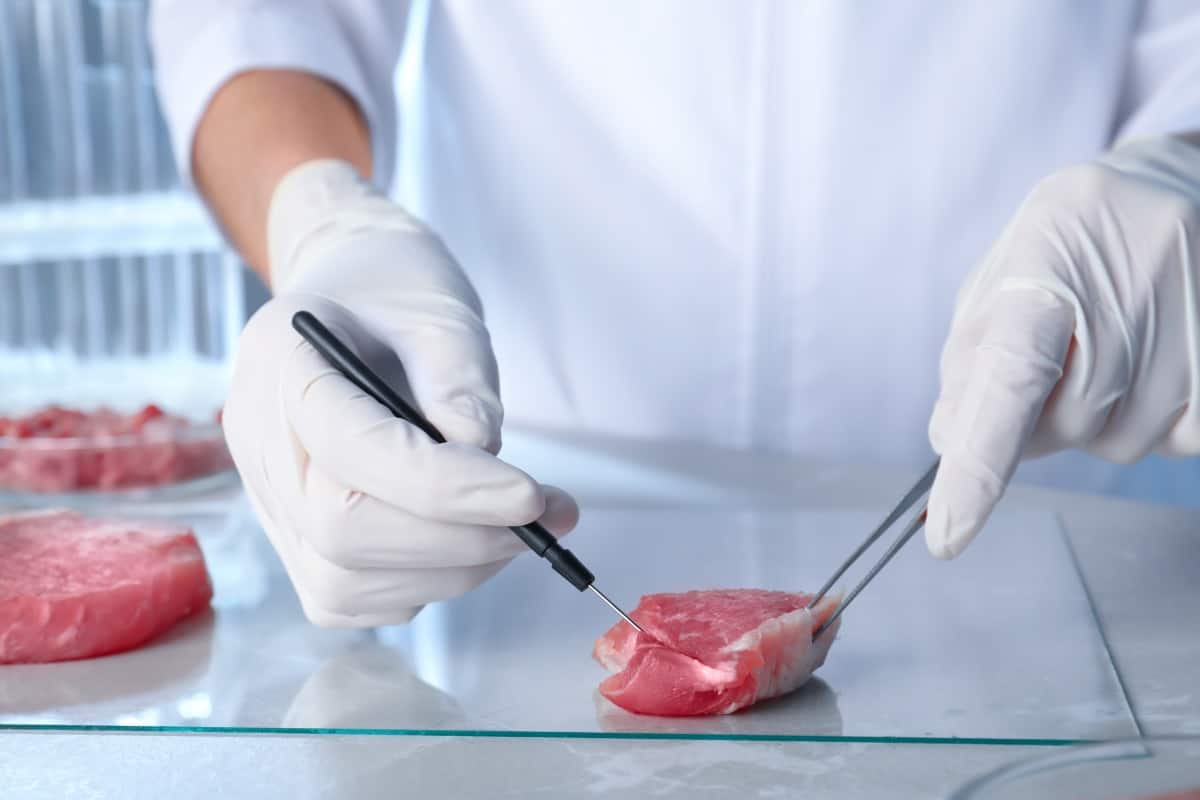
Champions of grass-fed beef are quick to point out its health benefits, especially concerning good fats and vitamin content.
Critics say the differences are negligible, pointing out that five times the vitamin E can be had from a handful of almonds than from a burger (grass or grain-fed). Note too that flaxseed and fatty fish are significantly richer in omega 3 fats and, for your daily dose of vitamins and minerals, a handful of fruits and vegetables fills the bill better than beef does.
The bottom line? There clearly is a nutritional difference between grass-fed and grain-fed. And at some level, it just plain makes sense that it’s healthier for us to consume an animal that eats what it’s born to eat instead of something it needs assistance from drugs to digest. But — and it’s a big but — the nutritional differences are small.
What is significant is the lower fat and calorie content of grass-fed over grain-fed beef. And for those who enjoy a tasty steak and a trimmer waistline, grass-fed makes an excellent choice.
In the end, it may just feel good to you to eat beef that you know has been raised and fed naturally and traditionally, is hormone and antibiotic-free, lower in fat, and has slightly higher levels of vitamins and healthful fats.
Then again, you may prefer…as many restaurants and steakhouses prefer…to choose a grain-fed beef that will be juicier and arguably more flavorful because of its higher fat content. And with certain high-end cuts like tenderloin and rib-eye, well, that quality grain-fed fat really knocks it out of the park. With these premium cuts, most chefs will recommend grain-fed for a truly top-quality tender and juicy end-product. The choice is yours.
Price Difference Between Grass-Fed and Grain-Fed Beef
Grass fed is more expensive than grain fed beef. Time is money. And space is money. So an animal that takes more time and more land to raise is going to put a bigger dent in your pocket at the supermarket. This is the way it is with cows that are exclusively grass-fed (strictly speaking: grass-finished).
And of course, sheer production volume — less than 3% of US beef sales — is lower with grass-fed cows, which makes their operating costs higher. However, based on renewed consumer demand for a healthier, more natural beef, numbers have grown from just 50 grass-fed producers ten years ago to over 2000 today, an estimated growth rate of 25% annually! But this is still small fry compared to the feedlot giants of beef production in the United States.
In the feedlot, massive numbers of cows are efficiently packed into small spaces and fast-tracked to weight gain with calorie-laden grain. Not only is the grain-fed cow significantly heavier than its grass-fed counterpart at slaughter, but they are on average 10-12 months younger at maturity too. This is a win-win for producers who achieve their goal sooner and at a lower cost enabling them to keep their costs down for the consumer.
Jo Robinson, of Eatwild, has spent the past ten years examining scientific research that compares grass-fed and grain-fed animals. She says:
“Conventional factory meat is so cheap because they’ve done everything to speed growth and lower the cost of feed.”
So how much more are you forking over at the check-out for grass-fed beef? Consumer Reports says on average, you can expect to pay an extra $2.50-3 per-pound for grass-fed. If you bought a couple of pounds a week on average, this could amount to an additional $260-310 per year.
Money-Saving Tip!
Invest in a freezer, and buy grass-fed beef in bulk directly from farmers or local suppliers.
CSAs (Community Supported Agriculture) and “cow-sharing agreements” (or cowpools …how great is that!) are also great cost-cutting options. By cutting out other stages in the distribution process, you can keep costs in line with grain-fed.
Which is better for the Cows? Feeding Grass or Grain?
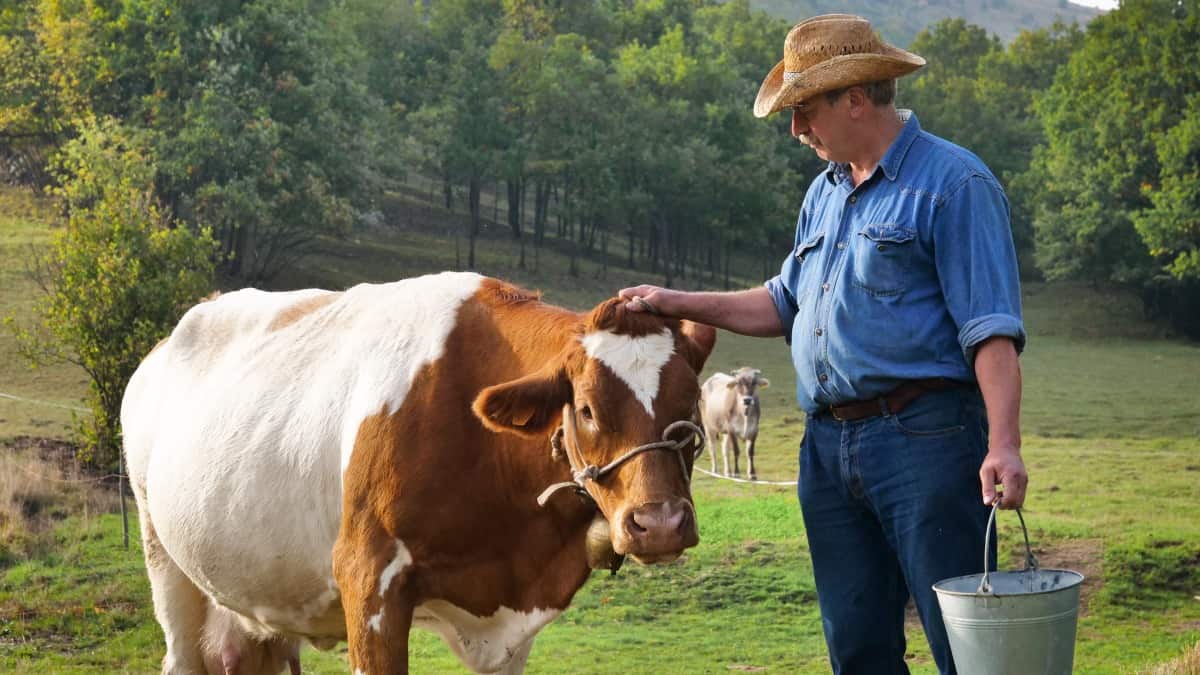
Well, as you might guess, this one’s pretty straightforward. Grass feeding is better for cows than grain feeding. Cows are happier and healthier doing what cows are built to do, which is roam around freely and graze on grass. Unfortunately, in the multi-billion dollar business of beef production, the cows’ opinion doesn’t count for much.
But what about grain-feeding, is it good for the cows? The answer is no. High-carb grain feed creates an acidic environment in the cows’ digestive tract which can lead to infection and ulcers. So grain-fed cows must be supplemented with antibiotics to help their systems process grain. Hmm, not the way Nature intended.
Here’s some more solid information about the differences in pasture and feedlot lives, from the cows’ perspective.
Grain-feeding, says Will Harris, a Georgia rancher at White Oak Pastures, is like giving cows “a big bowl of candy” …they like it, but it’s no better for them than it would be for us to munch through large bowls of candy day in day out.
Combined with a sedentary lifestyle where the animals don’t have much room to move freely, this quickly makes them reach unnatural levels of obesity. Great for juicy steaks. Not great for the cows.
The conditions of grain-feeding lots are also not pleasant for the cows. Zero natural vegetation, a deep soup of mud and feces, and overcrowding can all contribute to stress and disease. Hence, the widespread use of antibiotics.
What is the Environmental Impact of Grain-Feeding Compared to Grass-Feeding?
There’s no way around it. To satisfy the sky-high demand for beef in the US, cattle farming takes an enormous toll on our planet both in open pastures and purpose-built feedlots. Scientists at Japan’s National Institute of Livestock and Grassland Science estimates that producing 1 kilogram of beef emits more greenhouse gas than driving 155 miles.
We’re talking hundreds and thousands of large animals here, and either they need acres upon acres of grassy land to graze on, or acres and acres of land to grow their feed. In fact, much more of the grain grown in the US goes to feeding animals than humans, about 80%, all of which requires a lot of energy to produce and transport.
Here are some of the environmental pros and cons of grass and grain feeding cattle:
Grass Feeding Environmental Impact
Pros
- Helps preserve grassland ecosystems by recycling nutrients
- Uses natural land on a sustainable rotational basis meaning cows are regularly moved in order to allow vegetation to grow back.
- Cows naturally fertilize the land with their waste
- Some carbon produced by cows in the form of methane is sequestered (trapped organically and safely) in the soil
Cons
- Some estimates say it takes 9 acres to raise just one grass-fed cow
- Cows produce methane (both grass— and grain-fed) a powerful and harmful greenhouse gas
- Not enough green space in the world to grass-feed all animals, simply not feasible
- Water consumption is high, with concentrated irrigation required for all the pasture
Grain Feeding Environmental Impact
Pros
- Animals reach slaughter weight much faster and more efficiently using fewer resources
- A shorter life-span means each animal produces less methane during its life
- Grain can be grown on land that’s unsuitable for pastures, making better use of available agricultural space.
- The way cows digest a corn-based diet results in less methane output
Cons
- Groundwater pollution from CAFO manure runoff
- Overuse of antibiotics leading to “superbugs.”
- Vast areas of land are devoted to growing the grain to feed the cows
- Huge quantities of fertilizer are used to help the grain grow
- Cows produce methane (both grass— and grain-fed) a powerful and harmful greenhouse gas
- Poor air quality (and this is putting it mildly) …the dust and stench of a feedlot can hit you like a cattle truck a good mile away
Should You Cook Grass-Fed Beef Differently from Grain-Fed Beef?
Yes, you should cook grass-fed beef differently to grain-fed beef. Being leaner with less marbling means grass-fed beef will require a little more care on the grill. Steaks like rib eye, Porterhouse, T-bone, and NY strip are among the most tender cuts of beef and so are well-suited to the grill.
The secret is to sear at high heat only very briefly, then, using a 2-zone set-up on your grill, switch the meat to indirect heat to finish cooking. This will prevent the more muscular structure of the meat from tightening up and becoming tough. I always recommend using a thermometer, especially when grilling over indirect heat, so you can be sure the meat reaches safe internal temperatures.
Another option you have is slow-cooking larger cuts over low heat. Slow-cooking over indirect heat on the grill helps break down connective tissue and turns tough collagen into melt-in-the-mouth goodness.
With a significantly higher fat content and the delicate white marbling so prized by steak lovers everywhere, grain-fed beef is a surefire winner. Easy to grill, you can pretty much count on a juicier steak every time.
A Word about Pasture-Raised, Organic, and Free-Range.
You just want to grab some burgers…but so many choices! In addition to the explanations of terms given earlier, here’s what you need to know.
Organic — Certified organic beef can be grass or grain-raised, as long as no hormones or antibiotics, drugs or chemicals of any kind have been used. Also, the animals must have access to a pasture.
Pasture-raised — Cows that have been pasture-raised must have received a significant portion of their nutrition from organically managed pasture and stored dried forages. Unlike 100% grass-fed cows, pasture-raised cows may also get a supplement of organic grains.
Free-range — This is a tricky one. In general, animals with the “free-range” label have access to open space, but it doesn’t mean they use it or that it’s an organic fresh green space. Also, the USDA does not require a common standard for producers who claim “free-range”. So they can define free-range however they like. Your best bet is to look for additional explanations of the free-range term on the label.
What’s Your Beef?
There’s a lot to digest here, and we hope we’ve helped clarify the major differences between grass-fed and grain-fed beef. Some of it is simple, and some — especially the term “grass-fed — is pretty slippery, with no clear-cut standardized definition in sight.
My advice? Understand the labels. If eating beef that has only known the joy of the open pasture is important to you, look for “grass-finished.” If you don’t want any drugs and chemicals messing with your steak, look for “organic.” Want a killer juicy steak that’s affordable too? Go for “grain-fed.” You have options. And now you have knowledge too! And as long as you take a few moments to check out the labeling at the meat counter, you’ll find what you’re looking for.
But remember, grass-fed or grain-fed, it’s going to be good because it’s beautiful, delicious juicy beef. And that, folks, is what’s for dinner!
What’s your feeling about grass-fed versus grain-fed beef? Is taste most important to you? Or how the animals live their lives? What about cost? Or cost to the environment? We’d love to hear what you think. Please share with us and share this post with friends.


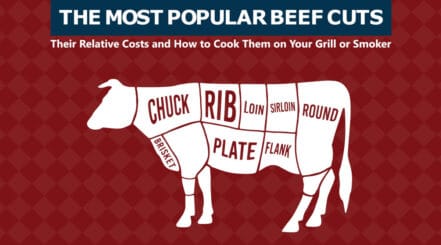
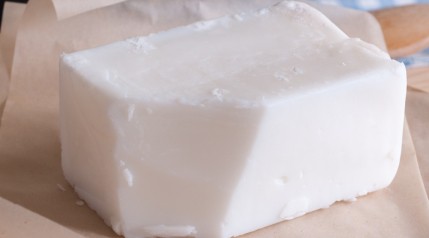
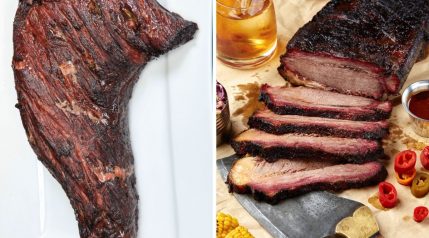
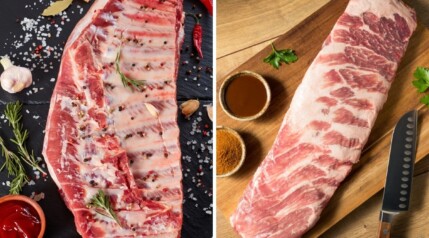
Very helpful. I’m buying a quarter grass fed cow this spring. Work with someone who has a farm and they raise cattle. Not Angus because they have to get certified… But I had heard grass fed was healthier. That’s what I got from your 2 articles.
I raise grass only with some minerals, no shots, no brand, no ear tag, cut their nuts off and let them grow. processing 3 if the best ever non vaxed grass fat 30 month old teers, will be healthy and well marbled, lots of fat and very tender. Will be grilling and giving education to local folks about nutrition. Nice site, O could lend a little to it, but not much !!!